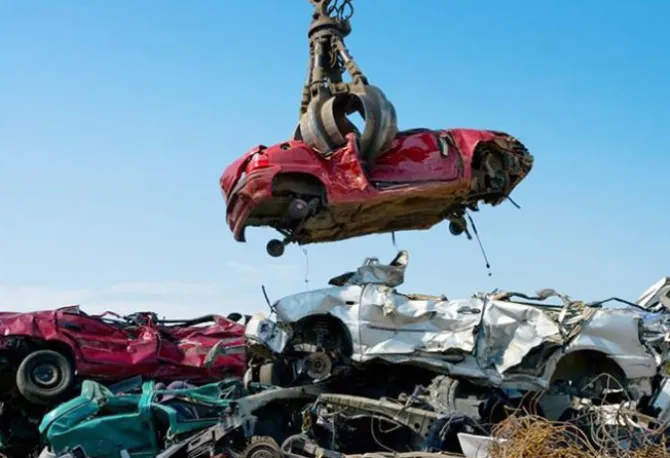-
CENTRES
Progammes & Centres
Location
The vehicle scrappage policy should be implemented as it would allow for greater mobility and enable municipal sweepers to keep the roads clean

A scrapyard is a place in a city or outside of it designated for assembling wrecked or decommissioned vehicles and then systematically dismantling them. Scrapyards go by different names in different countries, such as a wrecking yard or junkyard. In the process of disassembly, the usable parts are recovered and sold for further use in automobiles and the unusable metal parts are sold for recycling. Recently, the Government of India (GoI) has come up with a vehicle scrappage policy under its Voluntary Vehicle Fleet Modernisation Program (V-VMP). The Program has the following objectives: Bring down pollution by scrapping 10 million vehicles without valid fitness and registration; make road, passenger and vehicular safety better; enhance sales of motor vehicles and create employment; improve fuel efficiency and cut down maintenance costs for vehicle owners; give formal shape to the vehicle scrappage industry; and boost the availability of low-cost raw materials for the automotive steel and electronics industry.
Scrapyards go by different names in different countries, such as a wrecking yard or junkyard.
The scrappage policy has made it mandatory to scrap commercial vehicles after 15 years if they fail to meet prescribed fitness standards or exceed stipulated emission limits, bringing a 15-20 percent reduction in vehicular emissions. The policy also proposes a road tax rebate of 15 to 25 percent and a full registration fee waiver if an old vehicle is scrapped and a new one is purchased. It also exhorts auto companies to offer a 5-percent discount against a certificate of scrapping. The policy prescribes disincentives such as increased fees for fitness tests and issuance of fitness certificates for vehicles above 15 years of age as well as increased re-registration fees for such old vehicles. The policy also outlines key steps for facilitating the setting up of necessary support infrastructure in the form of automated testing stations (ATS) and registered vehicle scrapping facilities (RVSF). Some states have gone ahead and prepared their own vehicle scrappage policy (VSP). The government of Maharashtra, for instance, has prepared a VSP 2023 under the guidelines of the Ministry of Road Transport and Highways (MORTH), that mandates the implementation of the policy by any entity. The implementation of this policy should see a substantive rise in the scrapping of vehicles since it is estimated that India has 1.7 million heavy and medium commercial vehicles over 15 years old and 5.1 million light automobiles over 20 years old. This number is bound to continue to mount if vehicle scrapping is not addressed in earnest. Clearly, GoI’s policy, as stated above, is to get more vehicles on the road to expand the pool of employment.
The policy prescribes disincentives such as increased fees for fitness tests and issuance of fitness certificates for vehicles above 15 years of age as well as increased re-registration fees for such old vehicles.
What is not stated by GoI’s policy is that commercial vehicles and personal automobiles are going to operate overwhelmingly in cities. It is the larger cities that will predominantly have to provide right of way to these rising numbers on their roads. Traffic congestion in Indian metropolitan and megacities, therefore, is going to get worse since the best efforts at providing more space on city roads will not be able to keep pace with the inflow of vehicles. This is already translating into two adverse outcomes. More road space is getting consumed by on-street parking. Consequently, moving traffic is getting constricted as only part of the road remains free for travel. Surprisingly, and less talked about, is the fact that junked vehicles also substantially occupy city road space. Currently, such vehicles lie unattended on the streets, under flyovers or parking spaces, as there are very few dedicated land areas in Indian cities allotted for a vehicle scrapyard where junked vehicles can be stored and dismantled. To make matters worse, part of the scrappage business also gets done in many cities on the roads by odd, informal groups who engage in such activity. These developments choke mobility in cities and add to their unkempt appearance. With GoI’s pro-automobile policy, cities may not be able to prevent the inflow of vehicles. However, they could make on-street parking and parking stipulations more stringent and push parking into off-street parking. Cities could also allow more parking to be created within residential and commercial developments through more liberal regulations in the city’s development control regulations. Moreover, they could make it mandatory for a car buyer to produce proof of parking before a vehicle purchase is allowed. This, however, appears less likely since the appetite for harsh regulations in regard to vehicles does not seem to exist at the city or state level. A further step that cities are already taking is to construct large parking lots where parking can happen without causing any hindrance to city mobility.
Cities could also allow more parking to be created within residential and commercial developments through more liberal regulations in the city’s development control regulations.
Irrespective of the possible steps stated above, there could be no justification for allowing city roads to be used for amassing junked vehicles. They definitely need to go to the vehicle scrapyard. However, cities are amiss in not providing space in their land-use plan for a sufficient number of scrapyards. While private businesses may be eager to engage in the vehicle scrapping industry, the most difficult impediment faced by them is the availability of land for vehicle scrapyards. The neglect of this vital infrastructure in Indian cities can be gauged from the fact that the United States (US) has 7,927 junkyards. On the other hand, the Ministry of Road Transport and Highways has listed less than 100 RVSF in various states of the country. It is best that the urban local bodies (ULB) in India provide part of the solution. The first step towards this is to provide scrapyards in their master plan or development plan. The ULBs would also have to equip themselves with requisite authority under the Motor Vehicles Act to tow abandoned vehicles and fine owners for such unauthorised dumping on the road. Once land is made available, the site needs to be developed for RVSF. However, the procurement of appropriate technology, especially for electrical vehicles, adequate infrastructure, suitable machinery and equipment is vital. These areas, likely to require constant innovation, are best left to the private sector. There is already a readiness shown by Tata Motors to provide technical know-how and expertise to its dealers who are willing to invest in vehicle scrapyards. Others are likely to step in, given the fact that the business of vehicle scrapping has huge potential.
The ULBs would also have to equip themselves with requisite authority under the Motor Vehicles Act to tow abandoned vehicles and fine owners for such unauthorised dumping on the road.
The ULB should devise a business model where the ULB keeps out of running the business itself, but allows a private party to engage in the business on land provided by the ULB. Through a bidding process, the ULB can select a variable, such as annual land rent on which interested parties can bid for the contract. A certain percentage of land rent increase can be built into the contractual document. The selected business entity would, of course, invest in site development, technology and equipment and then run the scrapyard. It would also have to bear property tax, electricity charges and any other municipal levies that are stipulated. Evidently, the private sector would seek a substantial period of lease on land to enable it to recover the cost of investment and profits. The ULB’s primary interest would be to ascertain that city roads are not used for storage of junked vehicles, nor for engaging in the process of running a road-side scrapping business. This will free a reasonable percentage of road space currently occupied by such activity. It would allow greater mobility in the city, add to the aesthetics of the city’s road-side view and enable better sweeping work by municipal sweepers and cleaners. Clearly, implementing the vehicle scrappage policy at the city level does not deserve neglect any longer.
Ramanath Jha is Distinguished Fellow at Observer Research Foundation
The views expressed above belong to the author(s). ORF research and analyses now available on Telegram! Click here to access our curated content — blogs, longforms and interviews.

Dr. Ramanath Jha is Distinguished Fellow at Observer Research Foundation, Mumbai. He works on urbanisation — urban sustainability, urban governance and urban planning. Dr. Jha belongs ...
Read More +